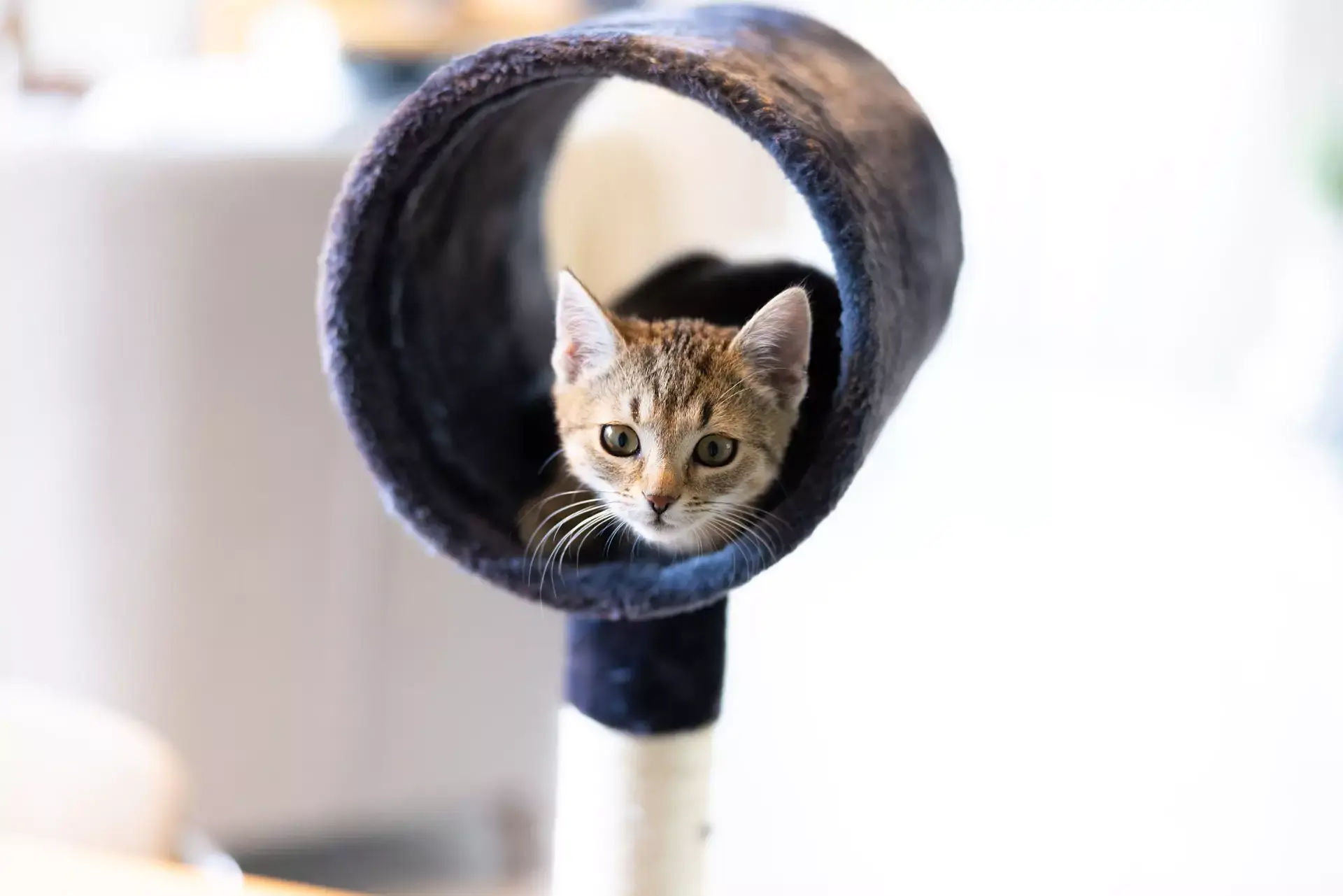Stress in cats is a prevalent yet often misunderstood issue that can significantly impact your feline companion’s quality of life. Just like humans, cats can experience stress due to various factors such as environmental changes, lack of stimulation, or underlying health conditions. Signs of stress in cats can be subtle, including excessive grooming, changes in appetite, or withdrawal from social interaction. In “Kitty Stress: Helping Fluffy Cope,” we explore the common causes of stress in cats, how to recognize the warning signs, and evidence-based strategies to alleviate their anxiety. By understanding stress in cats and implementing effective coping mechanisms, you can help your furry friend lead a happier, healthier life. From environmental enrichment and interactive play to behavioral therapies recommended by veterinarians, learn how to make a positive difference in your cat’s well-being.
Our feline pals are certainly very unique and purrsonable little furballs. After all, Fluffy is known to bite for fun, and she has a history of leaving us dead animals as a thank you gift for all of the food, toys, treats, and lap space we provide. But at the end of the day, these pint-sized lions are really pretty sensitive little animals. They, too, can experience loneliness, grief, fear, anxiety, and stress. This article by a local Rancho Santa Fe, CA veterinarian examines stress in cats.
How Can I Tell If My Cat is Stressed?
Fluffy cannot tell you how she feels, but if you pay careful attention, you can get a sense of your cat’s overall mood and state of being. Keep an eye out for behavioral indications.
Some of these include the following.
- Hiding
- Not wanting to be touched or petted
- Litterbox problems
- Overgrooming
- Eating non-food items
- Diarrhea
- Vomiting
- Panting
- Unusual, uncharacteristic or excessive vocalizations
- Clinginess
- Pacing
- Nervousness
- Aggression
- Spraying
- Weight Loss or Gain
You can also gain insight from Fluffy’s posture and nonverbal communication. Anxious kitties typically have dilated pupils. They might lick their noses, keep their ears flat against their head, and/or pull their whiskers back. Their tails may droop or be tucked tight to their bodies. Fluffy may stoop or hunch frequently, rather than drape herself over the back of the couch as a happy, calm cat would. She also may refuse to lay on her back and expose her belly, which is something our feline pals only do when they feel very safe.
Keep in mind that many of these symptoms might also be indicative of illness. It’s advisable to have Fluffy evaluated by her Rancho Santa Fe, CA veterinarian to rule out any medical issues.
How Can I Calm a Stressed Cat?
There are steps you may take to make Fluffy feel more at peace. Before you can you’re your pet cope, you’ll need to determine the root cause of your cat’s fear. A frightened rescue cat that is just starting to trust may require a different approach than a kitty who has always been an only pet and is now unnerved by the addition of a new baby.
If you have other pets and are concerned that there is conflict between them, you may want to take extra precautions. Make sure that Fluffy doesn’t have to fight with her roommates for food, water, toys, or the bathroom. Contact your veterinarian for further information.
How Can I Make My Stressed-Out Cat Feel More At Ease?
To manage stress in cats, it’s beneficial to turn your home into a calming sanctuary for Fluffy. You’ll want to design an environment where your anxious cat feels secure and relaxed. Thankfully, crafting a kitty comfort zone that reduces stress in cats can be straightforward and rewarding.
TLC: First and foremost, make sure your cat is receiving excellent care. Proper food, fresh water, a clean litterbox, and frequent veterinary treatment are all essential components of a proper cat care regimen. Ask your vet for specific advice.
Napping Spots: Provide Fluffy with plenty of comfortable napping locations. Kitties are not choosy about their beds, but they definitely do think more is better. Store-bought ones are wonderful, but Fluffy is also quite pleased to curl up on a folded blanket or pillow in a wicker basket.
Hiding Places: Nervous cats frequently seek refuge in safe and secure environments. They often really like small spaces. This makes sense: many anxious animals prefer confined settings because they feel safer when nothing can sneak up on them. Fluffy may prefer an enclosed kitty condo or a cat tower with enclosed areas. You can also provide boxes and create small nooks and crannies for your pet below the bed or behind the couch.
Kitten Comforts: Your furry pal will likely enjoy a cat tower with vertical space. Fluffy doesn’t have a good view from ground level, and often feels safer from a higher vantage point where she can see what’s going on around her. Paper shopping bags with the handles cut off will appeal to your pet. Then there’s Fluffy’s box obsession. Small gestures, such as leaving a lamp and radio on while you are away, would also be appreciated by your pet.
Scratching Posts: Scratching is a normal, instinctive, and healthy feline activity. Fluffy has an instinctual need to take care of her claws. After all, she relies on them for survival in the wilderness. Scratching may also be calming for cats. Provide a good tower, pole, or board for your kitty friend to do her nails on.
Window Seat: One simple way to keep that little motor running is to give your feline companion a window seat with a good view. Fluffy gets to enjoy three of her favorite activities: sunbathing, napping, and viewing local wildlife.
Toys and Playtime: Both entertainment and physical activity can help cats cope with stress. For one thing, running after that elusive red dot or pouncing on that catnip mouse will allow Fluffy to expend any anxious energy she may have. She’ll naturally feel calmer afterward. This is similar to someone going for a run to relieve tension after a hard day. Furthermore, when you take the time to hold a string toy, your feline pal will realize you’re doing something for her. This will make her feel more cherished and safe.
Playing might also help your pet build confidence. Cats really do have to concentrate to coordinate those complex run/pounce combos. Achieving a complicated pounce might boost your anxious pet’s confidence.
Positive Feedback: Cats misbehave occasionally due to anxiety. For example, a scared kitty may urinate outside of the litterbox. We know that’s frustrating to deal with, but punishing your cat for these transgressions might only worsen her anxiety. Plus, if she forms a bad association with her litterbox, that could cause her to avoid using the litterbox even more. It is also vital to recognize that cats are naturally fearful. (We understand that some of our feline friends are rather brazen and fearless, but even courageous kitties can be spooked easily.)
Always emphasize positive reinforcement and make each interaction with you pleasant and peaceful.
Calming Products: Speaking of calm, soothing products may also be beneficial. Follow the package directions exactly, and contact your veterinarian for particular advice and recommendations.
Medicine: Some of our feline companions may benefit from medications. Talk to your veterinarian about your cat’s stress and behavior, and ask for recommendations.
Routine: Cats have less to do than dogs, as far as daily activities. Fluffy doesn’t need to be walked, and she will manage to schedule her 34 daily naps on her own. That said, consistency can go a long way toward helping a pet feel safe and secure. Try to maintain a consistent routine for mealtimes and playtimes.
Finally, make sure your feline companion feels loved. You don’t want to draw attention to her, but doing simple things like giving her a forehead boop as you walk by, talking to her, offering her treats, and allowing her to curl up with you at night can help her feel appreciated.
What Are The Causes Of Stress In Cats?
Fluffy can grow stressed over many issues. Medical difficulties are a major concern. Moving, bringing a new pet into the house, and changing ownership are all stressful experiences for cats. Fluffy may also be scared because of previous trauma, injuries, or experiences. Loud noises can also disturb our feline friends. Conflict with other pets can be a major issue. Even boredom and loneliness can impact your furry companion! If you’re not sure why your pet seems stressed, consult your Rancho Santa Fe, CA veterinarian.
Understanding and Managing Stress in Cats in 2024
What specific emotions can cats feel?
Cats are capable of experiencing a range of emotions similar to humans, including loneliness, grief, fear, anxiety, and stress. These feelings can manifest through various behaviors and physical responses. For example, a stressed cat may hide, avoid being touched, experience litterbox issues, or display changes in eating habits. Recognizing these signs is crucial for providing the appropriate care and environment to support a cat’s emotional well-being. Consultation with a veterinarian can help rule out medical causes of such behaviors and guide appropriate interventions.
How do I handle stress between multiple cats?
To manage stress among multiple cats, it’s essential to ensure each has access to their own resources—food, water, toys, and litter boxes—to avoid competition. Create multiple safe zones and hideaways so each cat can retreat to their own space when needed. Regular, separate playtimes can help reduce tension and build confidence. Consider introducing calming products like pheromone diffusers that can help reduce anxiety. Consistent routines for feeding and play also provide stability, which is crucial for a peaceful multi-cat environment. If conflicts persist, consult a veterinarian or a feline behaviorist for tailored advice.
What are ‘catios’ and how can they help?
‘Catios’ are enclosed outdoor spaces designed to keep cats safe while allowing them to enjoy the outdoors. These structures range from window box-like extensions to spacious enclosed patios with climbing structures and perches. They provide a secure environment where cats can experience fresh air, sunlight, and outdoor views without the risks of traffic, predators, or getting lost. This stimulation helps reduce stress and boredom, contributing to overall better mental and physical health in cats. By enabling natural behaviors like climbing and observing, catios can significantly enhance a cat’s quality of life.
How should children interact with stressed cats?
When interacting with a stressed cat, children should maintain a calm and gentle demeanor. They should avoid loud noises and sudden movements that might further stress the cat. It’s advisable for children to give the cat space and allow it to approach them on its terms. Quiet, slow movements and speaking softly can help the cat feel more at ease. Supervision during interactions is crucial to ensure safety for both the child and the cat, and to reinforce respectful behaviors towards the animal’s boundaries.
How do I prepare my cat for vet visits?
To prepare your cat for vet visits, start by making the carrier a familiar space. Leave it open in your home with a comfortable blanket inside. Introduce positive associations by placing treats or toys inside, gradually increasing the time your cat spends there. On the day of the appointment, maintain a calm demeanor to help soothe your cat’s nerves. Consider using a pheromone spray in the carrier for added comfort. Schedule the visit at a time when the clinic is less busy to minimize stress from noise and other animals.
Book An Appointment At Our Rancho Santa Fe, CA Pet Clinic
Do you need to schedule an appointment at our pet hospital? Contact your nearest Rancho Santa Fe, CA animal clinic today!





